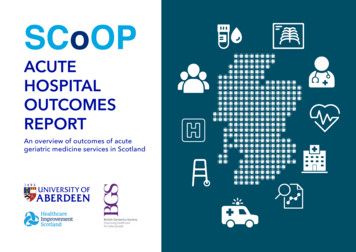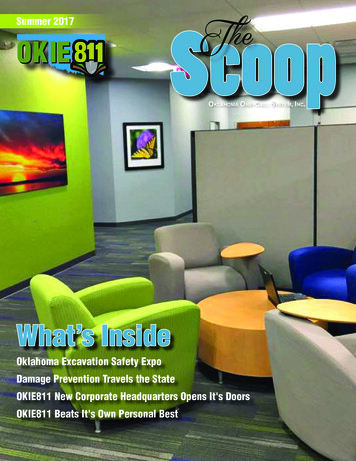
Transcription
SCoOPACUTEHOSPITALOUTCOMESREPORTAn overview of outcomes of acutegeriatric medicine services in Scotland
ContentsWorking Group0. 3SCoOP Steering Group . 4Members .4Scottish Care of Older People Project0 Acute Hospitals Report . 5What is SCoOP? . 6Executive Summary . 7Activity . 8Hospitals Report of Lenght of Stay . 9LOS by activibity and time out of speciality . 10Same Day Discharge . 12Deaths .13Readmissions . 14Hospital at Home . 15Aberdeen Royal Infirmary . 16Borders General Hospital . 17Dumfries and Galloway Royal Infirmary . 18Forth Valley Royal Hospital . 19Glasgow Royal Infirmary . 20Inverclyde Royal Hospital . 21Ninewells Hospital . 22Perth Royal Infirmary . 23Queen Elizabeth University Hospital . 24Raigmore Hospital . 25Royal Alexandra Hospital . 26Royal Infirmary Edinburgh . 27St John’s Hospital . 28University Hospital Ayr . 29University Hospital Crosshouse . 30University Hospital Hairmyres . 31University Hospital Monklands . 32University Hospital Wishaw . 33Victoria Hospital . 34Data . 352
Acute Hospital Outcomes ReportWorking GroupProfessor Graham EllisNational Clinical Lead for Older People, ScotlandHealth Care Improvement ScotlandSCoOP Steering Group Co-ChairDr Roy SoizaConsultant Physician, NHS GrampianSCoOP Acute Care Audit LeadProfessor Phyo K MyintClinical Chair in Medicine of Old Age, University of AberdeenSCoOP Steering Group Co-ChairMr Scott BuchananPrincipal Information Analyst, NHS National Services Scotland3
Acute Hospital Outcomes ReportSteering GroupCo-ChairsSecretaryProf P K MyintUniversity of AberdeenDr AIC DonaldsonUniversity of AberdeenProf G EllisNHS LanarkshireMembersDr L BeveridgeNHS TaysideDr T ByrneNHS Forth ValleyDr A EinarssonNHS ShetlandDr C McAlpineBGS ScotlandProf Sir Lewis RitchieUniversity of AberdeenDr R ThomasNHS FifeProf C BlackGrampian DASHDr P CantleyBGS ScotlandDr G HoyleNHS GrampianDr M McElroyNHS Glasgow & ClydeDr S ShenkinUniversity of EdinburghDr A WattNHS Ayrshire & ArranMr S BuchananNHS ScotlandDr A ConleyDumfries & GallowayMrs G JordanHISDr T QuinnUniversity of GlasgowMrs K WoodPharmacy SIGDr J BurnsBGS ScotlandDr A CoullNHS LothianDr A MacDonaldNHS HighlandMr G RamsayScottish SurgicalResearch GroupDr R L SoizaScottish Society ofPhysiciansSCoOP Secretariat:Room 1.130, Polwarth BuildingAgeing Clinical & Experimental Research TeamUniversity of AberdeenTel: 44 (0) 1224 4379634
Hospital Reports 2017/18Scottish Careof Older PeopleProjectAcute HospitalsReportThis is the SCoOP’s first Acute Hospitals Report to NHSBoards and Health and Social Care Partnerships. Itaims to help them assess their specialist acute geriatricmedicine services’ performance by highlighting variationin outcomes across Scotland.There are many factors that can account for variationin outcomes, including differences in case-mix, serviceconfiguration, resources and staffing. The report doesnot attempt to explain the variation but aims to stimulatethoughtful discussion, learning and action.The report should be used to help benchmark somekey patient outcomes and inspire a culture of interorganisational learning and continuous improvement.The wider goal is to reduce unwarranted andunjustifiable variation in outcomes, which may representa threat to patient safety and/or a failure to learn frombest practice.The report includes figures comparing outcomes across19 acute hospital sites and a summary for each hospitalsite. Data for some smaller hospital sites were removedfor disclosure reasons. Data for the Western GeneralHospital in Edinburgh are not available for this report asit does not have a major emergency department.For the purposes of this report, admissions were onlycounted where the majority of the total hospital stay wasspent in an acute hospital site.All data were provided by the Information StatisticsDivision (ISD).5
What is?“SCoOP is a Scottish national evaluation projectfocussing on care of older people across Scotland inboth primary and secondary care settings.”SCoOP has the following overarching aims: To evaluate the variation in service provision for olderpeople who require health and social care in varioussettings to serve as a driver for standardisation andimprovement of care across Scotland To provide benchmarking tools for various careaspects of older people in Scottish NHS health andsocial care setting to support improvement work inservices across Scotland To provide a health intelligence and knowledgetransfer hub for service users , health care providersand policy makers through annual evaluation cyclesThis is a joint initiative set up in late 2016 by three keypartners: Healthcare Improvement Scotland, the BritishGeriatrics Society Scotland Council, and the Universityof Aberdeen as the lead academic institution, withrepresentation from the other Scottish universities withclinical academic departments in Geriatric Medicine.6
Executivesummary The report measured outcomes of admissions to geriatricmedicine in the 19 largest hospitals with major emergencydepartments in Scotland. Admissions rose by around 10% peryear for three consecutive years, reaching 43,311 by 2017/18.This represents a growth in capacity most likely achieved througha reduction in length of stay. The number of admissions varied widely across sites, with someareas showing large increases in activity while others are indecline. There was enormous variation in length of stay across hospitals,with up to 12-fold differences in median length of stay. This wasnot explained by differences in length of stay in non-acute wards.Hospitals with higher activity levels usually had lower lengths ofstay, but this does not explain all the variation. There was a strong correlation between total length of stayand time spent out of specialty, suggesting delays in accessingspecialist services lead to longer stays in hospital. Length of stay has decreased across all sites by a median one dayin the last three years (range -7 to 5). Differences in readmission rates and mortality were lessmarked between hospitals. However, there were up to two-folddifferences in mortality rates at 30 days after admission betweenhospitals. Case-mix may account for some of the variation. Readmission and death rates have remained broadly stable overthe last 3 years, despite the substantial increases in activity. Three health boards reported the activity of their ‘Hospital atHome’ schemes, all of which have grown to accommodatearound 2,000 to 3,000 annual episodes each. The report highlights significant variation in outcomes across thecountry, and provides potential benchmarks for future qualityimprovement and greater consistency in outcomes.7
Hospitals Report 2017/18Activity There were 43,311 admissions to acutegeriatric medicine beds in 2017/18 Activity has increased nationally by around10% in each of the last 3 years from 32,009admissions in 2014/15 Changes in activity over the last 3 yearsvaried widely by hospital from a 41%drop in Ayr to an 84% increase in BordersGeneral Hospital Levels of activity in 2017/18 varied widelyby hospital from 187 to 7,113 admissions8
Hospitals ReportLength of Stay Shown here as complete lengthof stay in acute beds includingtime spent in non-specialtybeds Length of stay has fallen by amedian of 1 day across sitesoverall in the last 3 years (range-7 to 5) There is a 12-fold variation inmedian length of stay acrossthe country Length of stay in non-acutesettings ranged from 29 to 57days, with little correlation tolength of stay in acute settings9
Hospitals Report 2017/18LOS by activity and time out of speciality Funnel plots of all hospital rates versus activity, where dotted lines represent 2 and 3 standard deviations fromthe mean10
Hospitals with shorter patient stays out of specialty (usually denotingfaster access to specialist care) had significantly shorter overall lengthsof stay (r 0.86, p 0.001)11
Hospitals Report 2017/18SameDayDischarge Percentage of admissions to geriatricmedicine discharged on the same daythey were admitted Rates varied from 0% to 10.4%12
Hospitals Report 2017/18Deaths Mortality rates at 30 daysafter admission haveremained fairly steadynationally since 2013,averaging around 16.5% For 2017/18, mortality ratesat 30 days across hospitalsranged from 11.4% to 22.8% All 30-day mortality rateswere within 2 standarddeviations of the mean13
Hospitals Report 2017/18Readmissions Mean emergency readmission ratesat 7 and 28 days post discharge fromgeriatric medicine have remainedsteady since 2013 Mean emergency readmission rates at7 days averaged 6% (range 5-7%) Mean emergency readmission rates at28 days averaged 15.3% (range 1217%) Aberdeen Royal Infirmary had aslightly higher than expected 7–dayreadmission rate of 7.3% but at 28days readmission rates were notsignificantly different across sites14
Hospitals Report 2017/18Hospitalat Home Only three health boards reporteddata for their Hospital at Homeschemes Number of episodes increased 5-foldfrom 1,343 to 7,003 in three yearsHospital at Home - Number of episodes by financial year* and NHSBoardNHS Board ofTreatmentNHS FifeNHS LanarkshireNHS Lothian2017/18 comparison2014/15 2015/16 2016/17 11,8202,234Hospital at Home - Median duration of episode by financial year*and NHS BoardNHS Board ofTreatmentNHS FifeNHS LanarkshireNHS Lothian2014/15 2015/16 2016/17 2017/18676645557655* data prior to 2016/7 are marked as provisional Median duration of episodes is similarat 5 or 6 days across health boards15
Hospitals Report 2017/18AberdeenRoyalInfirmaryTotal throughput 2017/18 4,104Change over 3 years 14%Median LOS 3 days (rank 1st)Change since 2014/15 noneMedian out of specialty care 1 dayMedian LOS in non-acute care 41 daysReadmissions 7 days 7.3% (rank 18th)Readmissions 28 days 16.2% (rank 13th)Mortality 30 days 16.9% (rank 9th)16
Hospitals Report 2017/18BordersGeneralHospitalTotal throughput 2017/18 985Change over 3 years 84%Median LOS 24 days (rank 16th)Change since 2014/15 -3 daysMedian out of specialty care 6 daysMedian LOS in non-acute care 42 daysReadmissions 7 days 5.6% (rank 4th)Readmissions 28 days 13.7% (rank 3rd)Mortality 30 days 22.8% (rank 19th)17
Hospitals Report 2017/18Dumfries andGallowayRoyal InfirmaryTotal throughput 2017/18 1,141Change over 3 years -7%Median LOS 10 days (rank 8th)Change since 2014/15 noneMedian out of specialty care 2 daysMedian LOS in non-acute care 42 daysReadmissions 7 days 6.6% (rank 13th)Readmissions 28 days 17.1% (rank 19th)Mortality 30 days 18.6% (rank 13th)18
Hospitals Report 2017/18Forth ValleyRoyalHospitalTotal throughput 2017/18 5,723Change over 3 years 5%Median LOS 7 days (rank 3rd)Median out of specialty care 1 dayChange since 2014/15 noneMedian LOS in non-acute care 51 daysReadmissions 7 days 5.9% (rank 6th)Readmissions 28 days 14.2% (rank 6th)Mortality 30 days 15.3% (rank 7th)19
Hospitals Report 2017/18GlasgowRoyalInfirmaryTotal throughput 2017/18 4,272Change over 3 years 50%Median LOS 10 (rank 8th)Change since 2014/15 -3 daysMedian out of specialty care 2 daysMedian LOS in non-acute care 35 daysReadmissions 7 days 5.9% (rank 6th)Readmissions 28 days 16.5% (rank 15th)Mortality 30 days 14.1% (rank 3rd)20
Hospitals Report 2017/18InverclydeRoyalHospitalTotal throughput 2017/18 985Change over 3 years 12%Median LOS 25 days (rank 17th)Change since 2014/15 noneMedian out of specialty care 5 daysMedian LOS in non-acute care 35 daysReadmissions 7 days 6.5% (rank 12th)Readmissions 28 days 15.8% (rank 11th)Mortality 30 days 15.1% (rank 6th)21
Hospitals Report 2017/18NinewellsHospitalTotal throughput 2017/18 1,354Change over 3 years 33%Median LOS 12 days (rank 12th)Change since 2014/15 -2 daysMedian out of specialty care
Pharmacy SIG Members SCoOP Secretariat: Room 1.130, Polwarth Building Ageing Clinical & Experimental Research Team University of Aberdeen Tel: 44 (0) 1224 437963. 5 This is the SCoOP’s first Acute Hospitals Report to NHS Boards and Health and Social Care Partnerships. It aims to help them assess their specialist acute geriatric medicine services’ performance by highlighting variation in .











